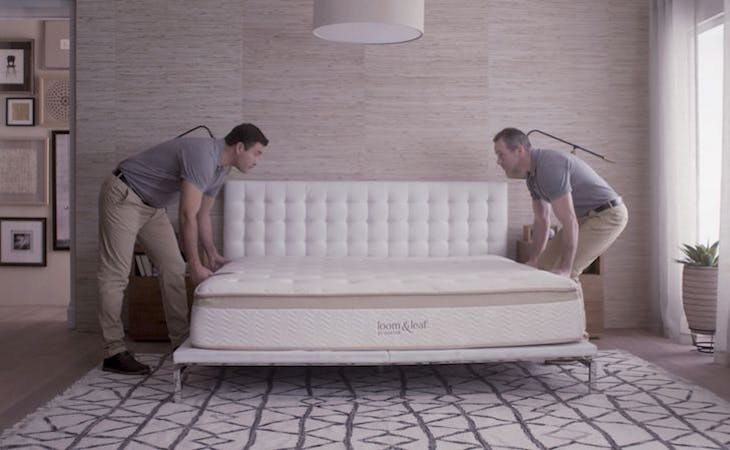Chances are it’s been a while since the last time you went mattress shopping. After all, the average lifespan of a mattress is around eight years, according to the National Sleep Foundation—and some mattresses last even longer than that. So it makes sense that you might be feeling overwhelmed by all the new choices if you’re looking for a new mattress for the first time in a long time.
To help ensure you don’t end up with any unwanted surprises—and that you enjoy your new purchase for years to come—we’ve put together this list of common mattress-shopping mistakes to avoid.
Mistake #1: You buy a mattress based solely on price
You might be tempted to settle for the lowest-price mattress when shopping, but that’s not necessarily the wisest decision.
Typically, the mattresses that cost the least are ones that are compressed into a box and shipped to your door. These so-called “bed in a box” mattresses are made with lower quality materials in order to be compressed and rolled and usually only last for a handful of years, at most. In fact, according to recent consumer research, buyers of “bed in a box” mattresses expect to replace them after only four years.
On the other hand, the more expensive a mattress—up to a point—the better the materials and longer you can expect it to last. That said, you certainly don’t have to spend an exorbitant amount of money to find a quality mattress.
“There’s no research that shows you get a better sleep on a $20,000 mattress than on a $3,000 mattress,” says Michael Breus, PhD, clinical psychologist and fellow of the American Academy of Sleep Medicine. In general, Breus says, you can find high-quality options in the $1,000 to $3,500 range.
Keep in mind that some mattress types cost more than others within that range. While memory foam and innerspring mattresses generally sell for around the same price, latex usually costs a bit more, due to the cost of harvesting and processing the natural material.
Related: The lowdown on mattress costs
Mistake #2: You choose a mattress that’s way too firm
Many people confuse firmness with support and end up choosing the firmest mattress possible. But mattress firmness and mattress support aren’t the same things. Mattress firmness is a function of the amount and type of material in the top, or comfort, layer of the mattress, which determines how the mattress feels when you lie down on it.
To be supportive, a mattress doesn’t necessarily need to be firm. A soft mattress (also commonly referred to as a plush mattress) can still be supportive enough if its bottom layers provide the appropriate support for your specific body type.
Of course, there are instances when you might need a firm mattress. If you’re a stomach sleeper, weigh over 250 pounds, or have back pain, then a firm mattress might be right for you. But if you’re a side sleeper, back sleeper, or you’re of lighter weight, you might sleep more comfortably on a softer mattress.
Mistake #3: You don’t give your new mattress enough of a chance
While this mistake technically occurs post-purchase, not giving your new mattress enough of an adjustment period can seriously set you back—both in terms of potential return fees and time wasted looking for another mattress.
“There is a transition period when you go from an old, unsupportive mattress to a new supportive one,” says Wisconsin-based chiropractor Thomas Tozer. Not only does it take time for your body to adjust to a new sleep surface, but a mattress’s components (like springs and foams) have a break-in period as well.
That’s why Tozer recommends finding a company that offers a generous home trial policy. At Saatva, for example, we give you 365 nights to sleep on a mattress to see if it’s right for you.
Here’s what one Saatva customer had to say about the break-in period of their new mattress:
“The first week, it took a while to get used to the firmness of the mattress. I even thought about returning it as it felt the same as sleeping on the floor except in an elevated position. I decided to give it another week. This was crucial because the mattress DOES take time to break in and conform to your body. It’s been exactly 9 weeks to the day and the mattress feels GREAT!!”
Related: Can sleeping on a new mattress cause back pain?
Mistake #4: You skip over the fine print
In your rush to find a new bed, you might think it’s OK to gloss over the fine print. But before handing over your credit card, it’s important to take the time to understand what else you’re signing up for when it comes to fine-print policies like delivery, home trials, returns, and warranties.
Here’s a rundown of the most common fine-print policies and what to expect:
Delivery
This varies widely depending on where you buy your mattress. When you buy a mattress from a retail store, you may have to pay extra for mattress delivery and/or removal, based on where you live and the total cost of your purchase. Some companies, like Saatva, offer free white glove delivery, which includes delivery and setup of your new bed, plus removal of your old mattress. Bed in a box companies, meanwhile, typically ship their mattresses for free, but the catch is you have to set things up yourself—and a queen mattress can weigh upwards of 90 pounds.
Home trial
As we noted, it can take time to adjust to a new mattress. That’s why most online mattress companies and many mattress stores give you at least 30 nights to try a new mattress at home, risk-free. Most home trials range from a few months to as much as a full year, which should give you plenty of time to decide whether your new mattress is right for you. Keep in mind that some companies require you to sleep on the mattress for a certain period (usually 30 nights) before you are allowed to return it.
Returns
If you’ve decided your new mattress isn’t right for you and you’re still within the home trial period, most mattress stores and online mattress companies will let you exchange or return it for little or no charge. Some companies may charge a pickup fee (Saatva charges a $99 processing fee to pick up a return, for example) or require you to return your bed in like-new condition, charging you for anything they deem damage.
Warranty
Like any big item, a mattress should come with a robust warranty that lasts for at least 10 years. At Saatva, we offer a “Friends for Life” warranty that lasts for as long as you own the mattress. Normal wear and tear isn’t typically covered by a warranty. Usually, a warranty covers sagging that is the result of something faulty in the mattress. Of note, certain conditions will usually void your warranty—for instance, if the mattress has stains or you used an improper foundation.
Wondering if it’s time to break up with your current bed? Here are signs it’s time for a new mattress.







